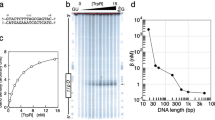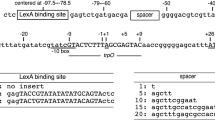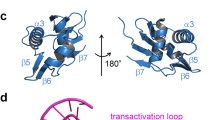Abstract
The investigation of protein–DNA interactions benefits from methods for the dissection of chromosomal DNA into handy fragments and their subsequent preparation in large amounts1,2. Of particular interest are proteins active in gene regulation and their interaction with the control sequences of the respective genes3. Recently, we reported4 the purification of the molecular components of the control elements from the tetracycline-resistance (tet) gene located on the transposon Tn10. The Tet repressor inhibits transcription of the tet gene and its own gene4. When the tet operator was prepared on a 187 base pair (bp) DNA fragment4, the Tet repressor was found to bind specifically to this fragment with a stoichiometry of four Tet repressors per DNA fragment4. Tetracycline inhibits this binding4 and operates in vivo as an inducer for the expression of the Tn10-encoded tetracycline resistance5,6. We now report thermal denaturation experiments of the Tet repressor–tet operator complex and demonstrate independently that four Tet repressor molecules bind to the 187 bp DNA and stabilize a 125 bp double-stranded DNA sequence against thermal denaturation.
Similar content being viewed by others
References
Hardies, S. C. et al. J. biol. Chem. 254, 5527–5534 (1979).
Hillen, W., Klein, R. D. & Wells, R. D. Biochemistry 20, 3748–3756 (1981).
Wells, R. D. et al. Prog. Nucleic Acid Res. molec. Biol. 24, 167–267 (1980).
Hillen, W., Klock, G., Kaffenberger, I., Wray, L. V. & Reznikoff, W. S. J biol. Chem. (in the press).
Yang, H., Zubay, G. & Levy, S. Proc. natn. Acad. Sci. U.S.A. 73, 1509–1512 (1976).
Wray, L. V., Jorgensen, R. A. & Reznikoff, W. S. J. Bact. (in the press).
Wang, A. C., Revzin, A., Butler, A. P. & van Hippel, P. H. Nucleic Acids Res. 4, 1579–1593 (1977).
Record, M. T. Jr, de Haseth, P. L. & Lohmann, T. M. Biochemistry 16, 4791–4802 (1977).
Hillen, W., Goodman, T. C., Benight, A. S., Wartell, R. M. & Wells, R. D. J. biol. Chem. 256, 2761–2766 (1981).
Hardies, S. C., Hillen, W., Goodman, T. C. & Wells, R. D. J. biol. Chem. 254, 10128–10134 (1979).
Riesner, D. & Romer, R. Physico-Chemical Properties of Nucleic Acids Vol. 2 (ed. Duchesne, J.), 237–318 (Academic, New York, 1973).
Hillen, W., Goodman, T. C. & Wells, R. D. Nucleic Acids Res. 9, 415–436 (1981).
Hillen, W. & Unger, B. Nucleic Acids Res. (in the press).
Alberts, B. M. & Frey, L. Nature 227, 1313–1315 (1970).
Johnson, A. D. et al. Nature 294, 217–223 (1981).
Author information
Authors and Affiliations
Rights and permissions
About this article
Cite this article
Hillen, W., Unger, B. Binding of four repressors to double-stranded tet operator region stabilizes it against thermal denaturation. Nature 297, 700–702 (1982). https://doi.org/10.1038/297700a0
Received:
Accepted:
Issue Date:
DOI: https://doi.org/10.1038/297700a0
- Springer Nature Limited
This article is cited by
-
A possible tertiary structure change induced by acrylamide in the DNA-binding domain of the Tn10-encoded Tet repressor. A fluorescence study
Journal of Protein Chemistry (1996)





